Tivoli Villa d’Este Gardens - Must-See Fountains on Tivoli Tours from Rome
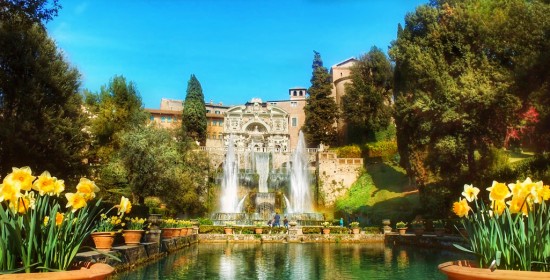
Buongiorno and welcome to Stefano’s RomeCabs, Rome’s top-rated tour company for private tours in Italy, Shore Excursions from Civitavecchia and Italy sightseeing transfers from Rome. Tivoli is one of the most popular destinations from Rome with the opportunity to explore both the imperial complex of Hadrian’s Villa and the Italian Renaissance Villa d’Este.
In this travel blog that accompanies our Tivoli Villas and Gardens Tour from Rome and Post Cruise Tivoli Tour, we take you through the Renaissance gardens of Villa d’Este to the best must-see fountains, where artistry and nature converge in a symphony of water, greenery, and timeless beauty. Discover the poetic allure of each fountain, a testament to the grandeur of Italy's cultural heritage.
Don’t miss our Guide to the Renaissance Rooms inside Villa d’Este which takes you on a guided tour of the Villa’s most opulent rooms and halls. It’s a perfect complement to this guide to the must-see fountains inside the gardens.
In Addition to Tivoli Tours from Rome, RomeCabs also offers the following opportunities to visit Villa d'Este in Tivoli:
- Post Cruise Tivoli Tour from Civitavecchia
- Rome to Amalfi Coast with a visit to Tivoli (Sightseeing Transfer)
Villa d’Este: Must-See Fountains
on Tivoli Tours from Rome
1. FOUNTAIN OF THE BIG GLASS (Fontana del Biccherone)
One of two fountains created by Gian Lorenzo Bernini between 1660 and 1661
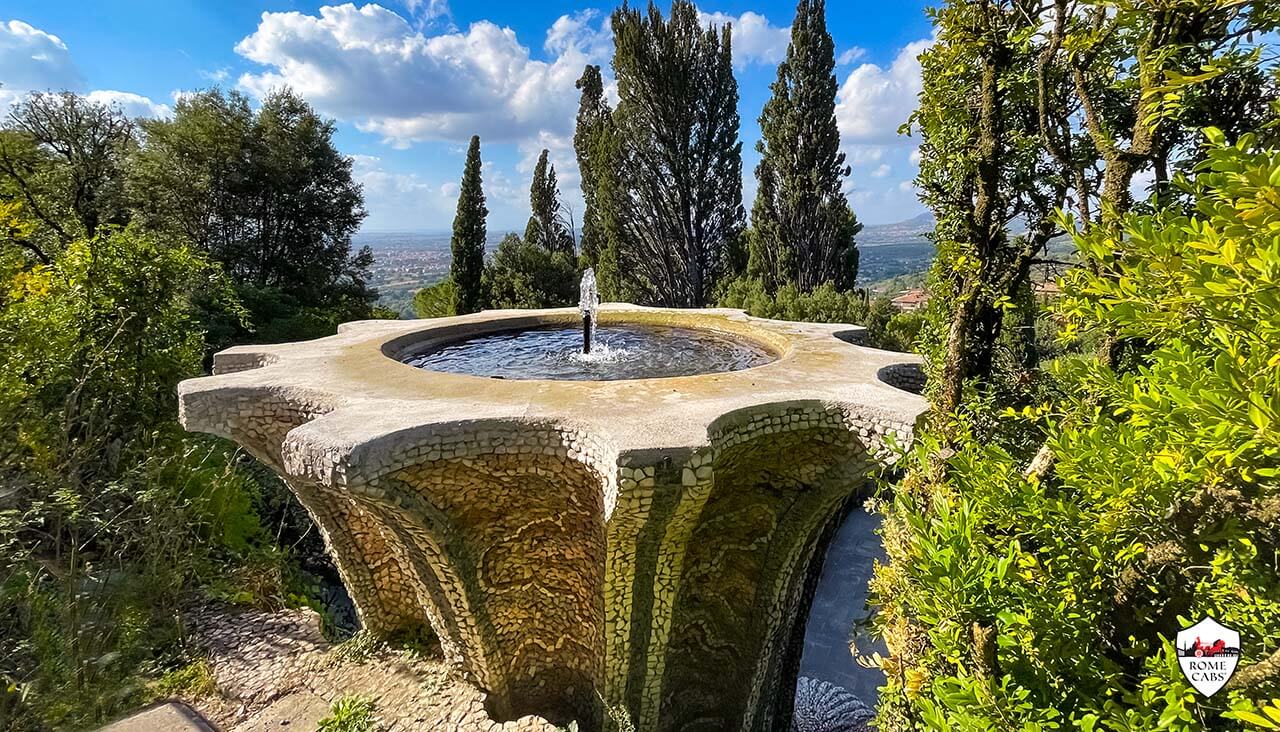
One of the first fountains you will see as you begin your exploration of the lush gardens of Villa d’Este is the Fountain of the Big Glass (La Fontana del Biccherone).
The fountain features a basin shaped like a large shell, extending up to the terrace level. At its center is a bicchierone (cup or chalice) from which water sprays upward.
The famous Gian Lorenzo Bernini oversaw the fountain's construction, and after its inauguration in May 1661, he lowered the height of the spouting water to prevent obstructing the view from the Loggia of Pandora. While not initially part of the garden's original design, the fountain later became a connecting element between the palace's architecture and the garden.
2. FOUNTAIN OF ROMETTA (Fontana di Rometta)
Constructed by fountain expert Curzio Maccarone between 1567 and 1570 as part of Pirro Ligorio’s project
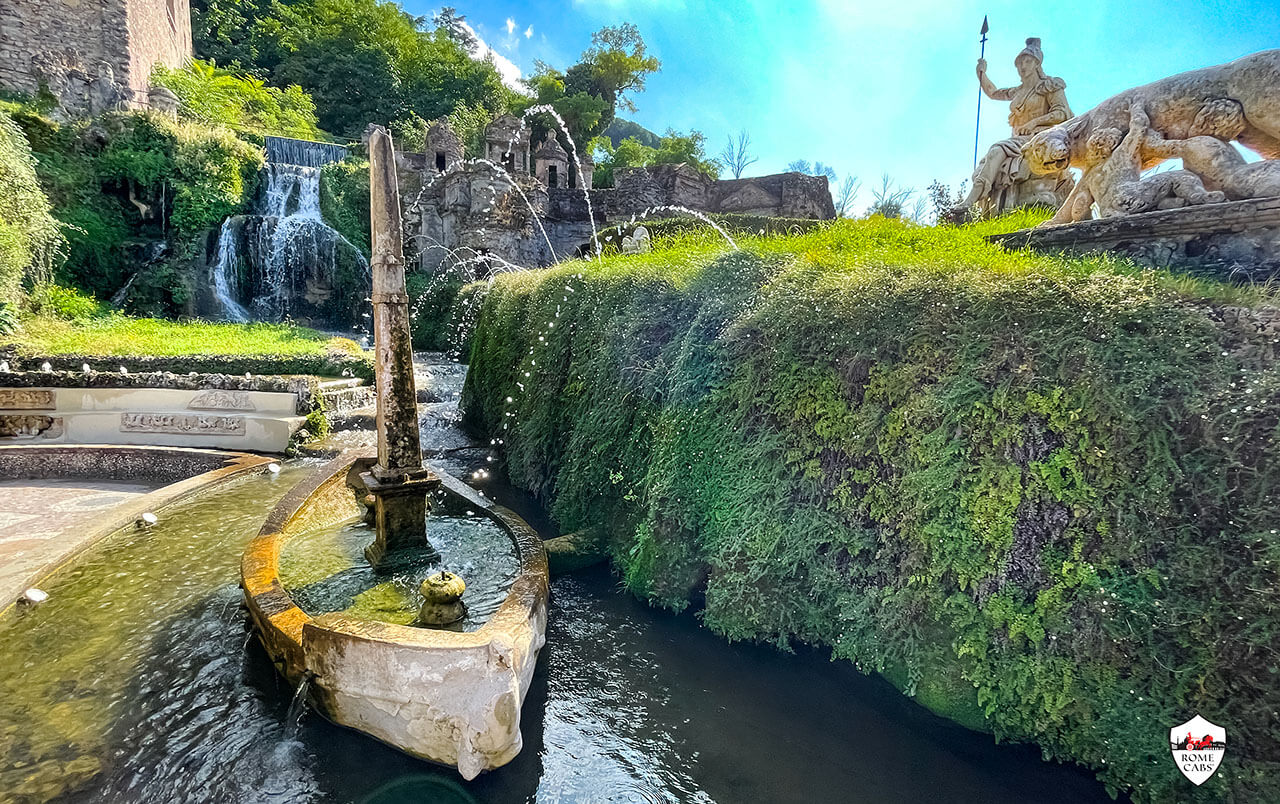
From the villa’s Vialone (Great Terrace) head left towards the Fountain of Rometta.
The Rometta Fountain marks the conclusion of the symbolic axis linking Rome to Tivoli through the Aniene and Tiber Rivers.
Initiating at the Tivoli Fountain, progressing through the Hundred Fountains, and culminating at the Rometta Fountain, the water journey features representations of the key monuments of Rome's Seven Hills (though partly demolished in 1850 due to structural issues).
Situated on an elevated terrace supported by imposing pillars, the Rometta Fountain resembles a theatrical scene. An expansive exedra showcases miniature reconstructions of Ancient Rome, reminiscent of Ligorio's maps from 1552 to 1561. In the center, Pierre de la Motte's statue of Rome Victorious (1568) and the She-wolf nursing the twins (placed in 1611) stand.
Within the left grotto, a marble statue portrays the Tiber flowing into a pool with a ship and obelisk, symbolizing Tiber Island. The scenic layout on the left commemorates ties to the Tivoli area, including an artificial mountain supported by the Apennine Mountains (with a statue inside the cave) and streams descending to join the Tiber. At a higher level, the stucco statue of the Aniene holds the Temple of the Sibyl in its left hand.
3. FOUNTAIN OF THE OWL (Fontana della Civetta)
Created by Giovanni del Duca between 1565-69
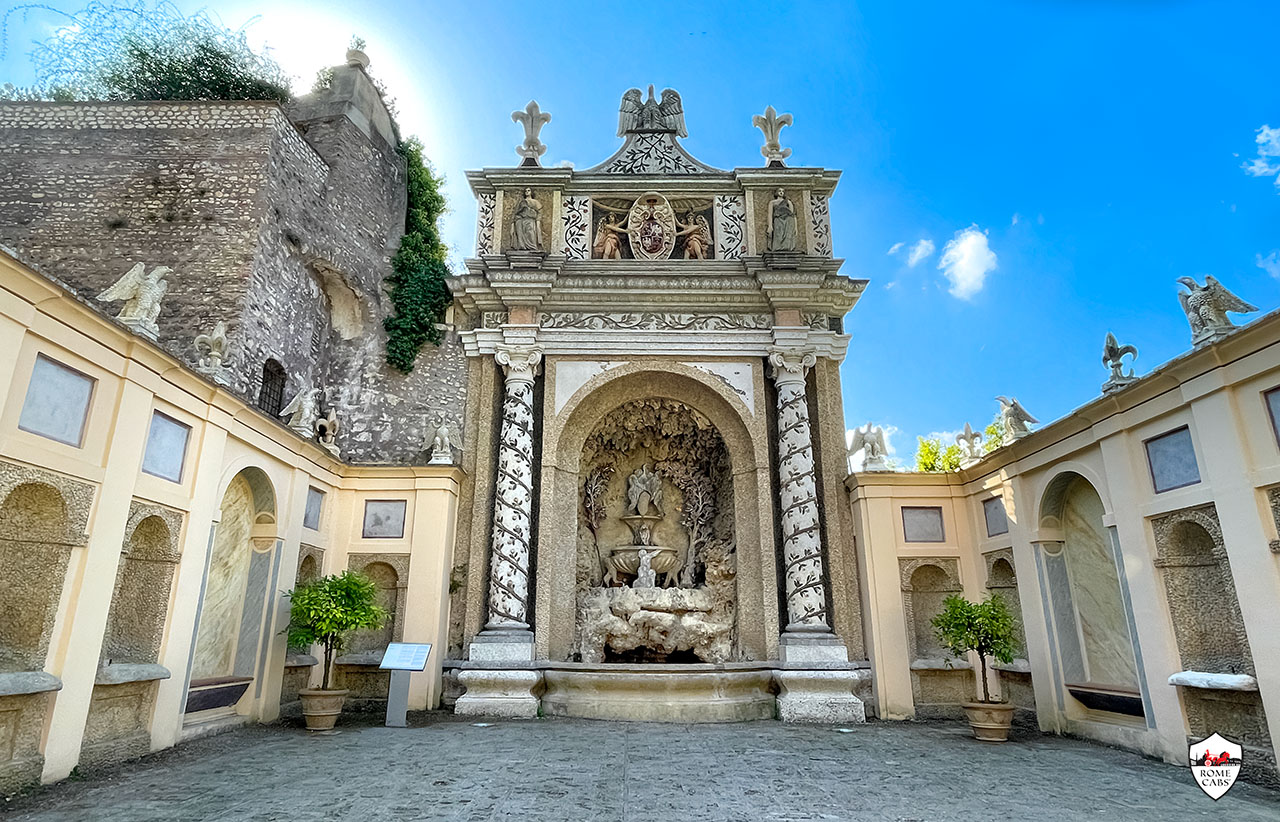
Near the Fountain of Rometta is the Fountain of the Owl (Fontana della Civetta), designed with a triumphal arch theme like the nearby Fountain of Persephone, which is a courtyard enclosed by a decorated high wall. It features arches and niches with water sprays, a large Ionic-column-framed niche at the back, and an attic bearing the crest of Cardinal Ippolito, flanked by winged figures and female characters. Mosaic decorations with polychrome marble tesserae depict Este family symbols, like golden apple branches spiraling up columns.
The niche retains stucco decoration from 1568, featuring children with a wineskin pouring water into a basin held by three satyrs (reimagined in 2002 by Emilio Farina). The Fountain is known for its hydraulic sound divide, created in 1566 by fountain maker Luc Leclerc, where bronze birds sang until an owl appeared, resuming singing once the owl left. Restoration in 2001–02 revealed original mechanisms, allowing a new version to be created by Leonardo Lombardi for the birds to sing and move again.
4. FOUNTAIN OF PERSEPHONE (Fontana di Proseperina)
Created by Alberto Galvani in 1569–70
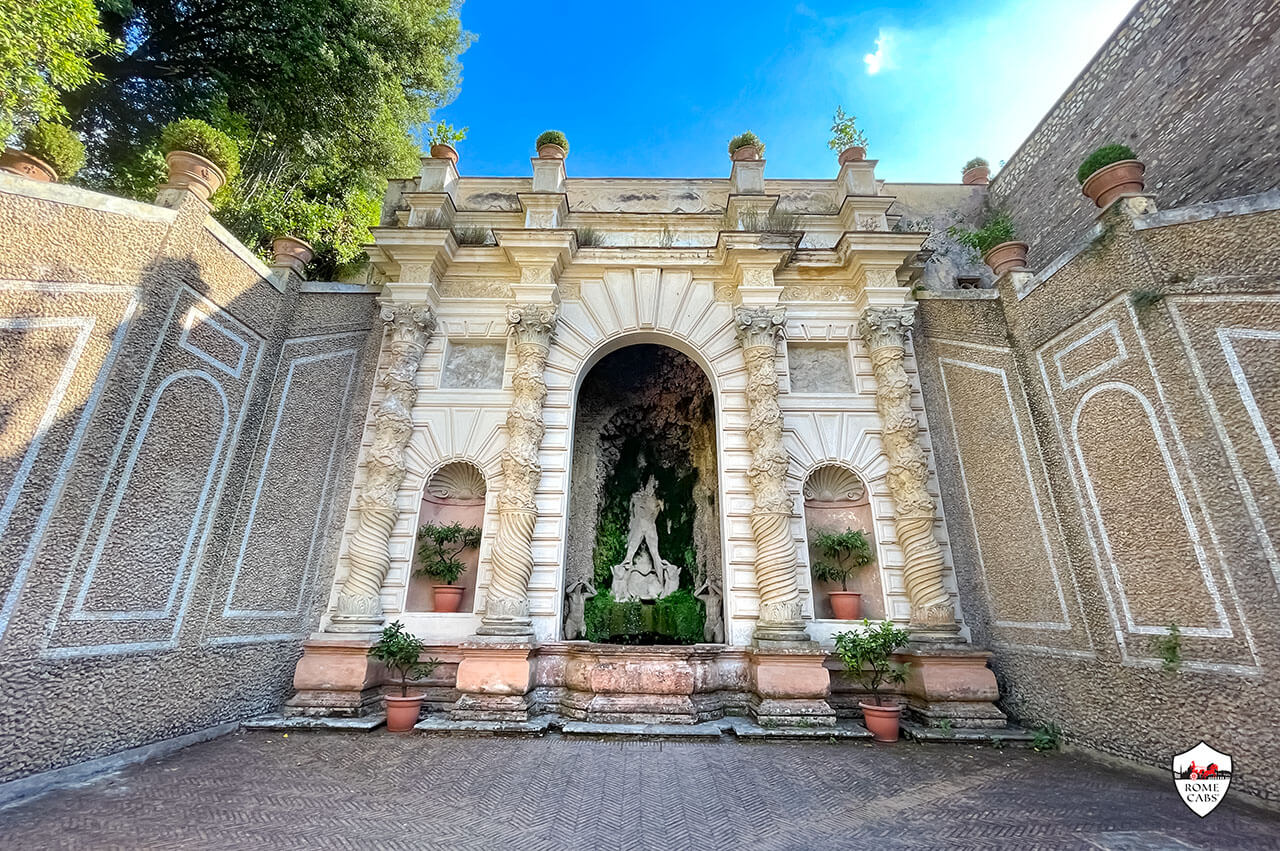
The Fountain of Persephone (Fontana di Proseperina), situated just above the Fountain of the Owl and connected by a stairway, was initially called the Fountain of the Emperors. It was designed to showcase statues of four Roman Emperors: Julius Caesar, Augustus Caesar, Trajan, and Hadrian. Two stairways, now reduced to one, connect it to the Rometta Fountain above, with parapets supporting water channels.
The small fountain courtyard is enclosed by the stairways, forming two sides. The fountain itself is set within a triumphal arch with twisting columns reminiscent of those in St. Peter's Basilica in Rome. The central niche once held a statue of the fertility goddess Persephone being kidnapped by Pluto, placed around 1640. While the statue of Persephone is no longer present, Pluto remains, carried on a shell supported by two sea horses. Niches on the sides contain statues of Tritons riding dolphins and playing buccina, or seashell trumpets.
5. HUNDRED FOUNTAINS (Cento Fontane)
Constructed between 1566 and 1577
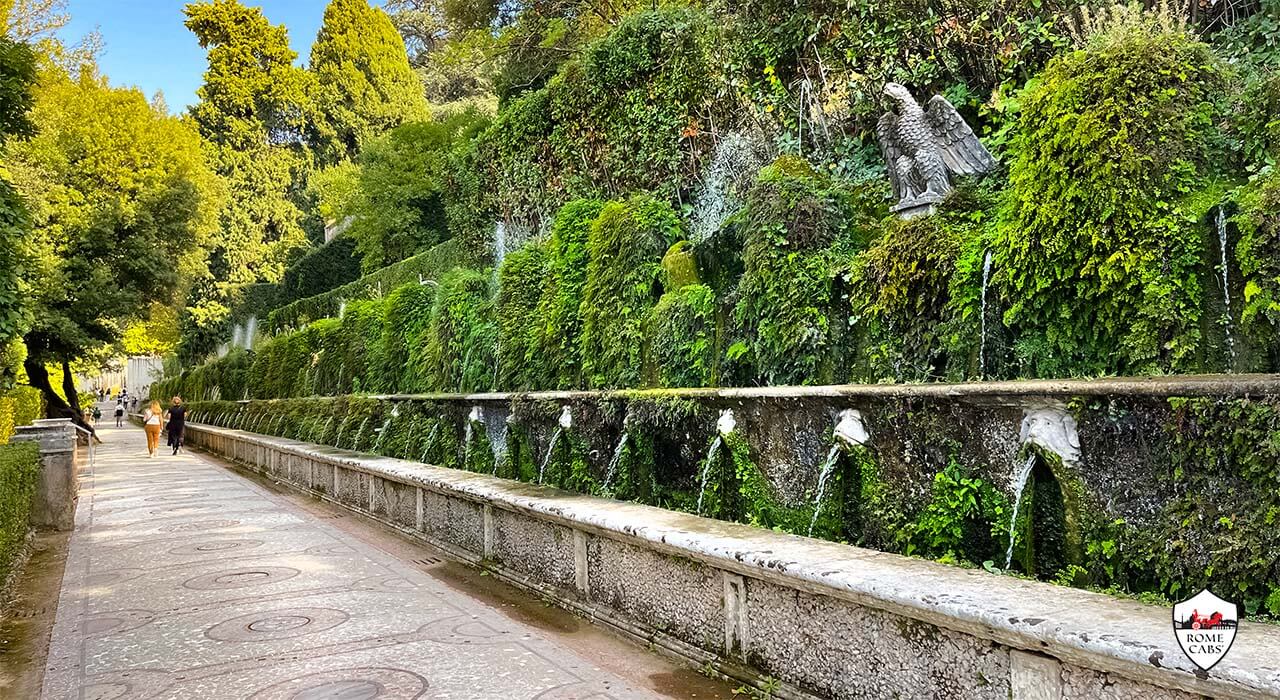
Proceed from this side of the gardens of Villa d’Este along the avenue of the hundred fountains to head to the other side of the gardens.
The Hundred Fountains (Cento Fontane), a renowned Renaissance garden marvel, sit between the oval fountain and the Fontana di Rometta. Nearly three hundred spouts, distributed across three parallel canals, feature lilies (symbolizing France), the d'Este eagle, boats, and obelisks along the upper canal. The water flows in a fan shape, captured by the second canal with spouts shaped like masks, ultimately reaching the lower canal.
Originally adorned with more features like small boats and terra cotta vases planted with fruit trees, the upper canal also displayed sculptural plaques illustrating scenes from Ovid's Metamorphosis. Over time, deterioration led to the removal or replacement of many decorations.
The wall, now heavily vegetated, underwent restoration in the 17th century, a subsequent period of neglect, and a final restoration in 1930. Symbolically, the canals and Hundred Fountains represented the aqueducts supplying water to Rome in the garden's overall plan. Celebrated in Italian art and literature, notably in Gabriele d'Annunzio's Roman Elegies, they remain a significant feature.
6. THE OVAL FOUNTAIN (Fontana dell’Ovato)
Created between 1566-1570 by Pirro Ligorio
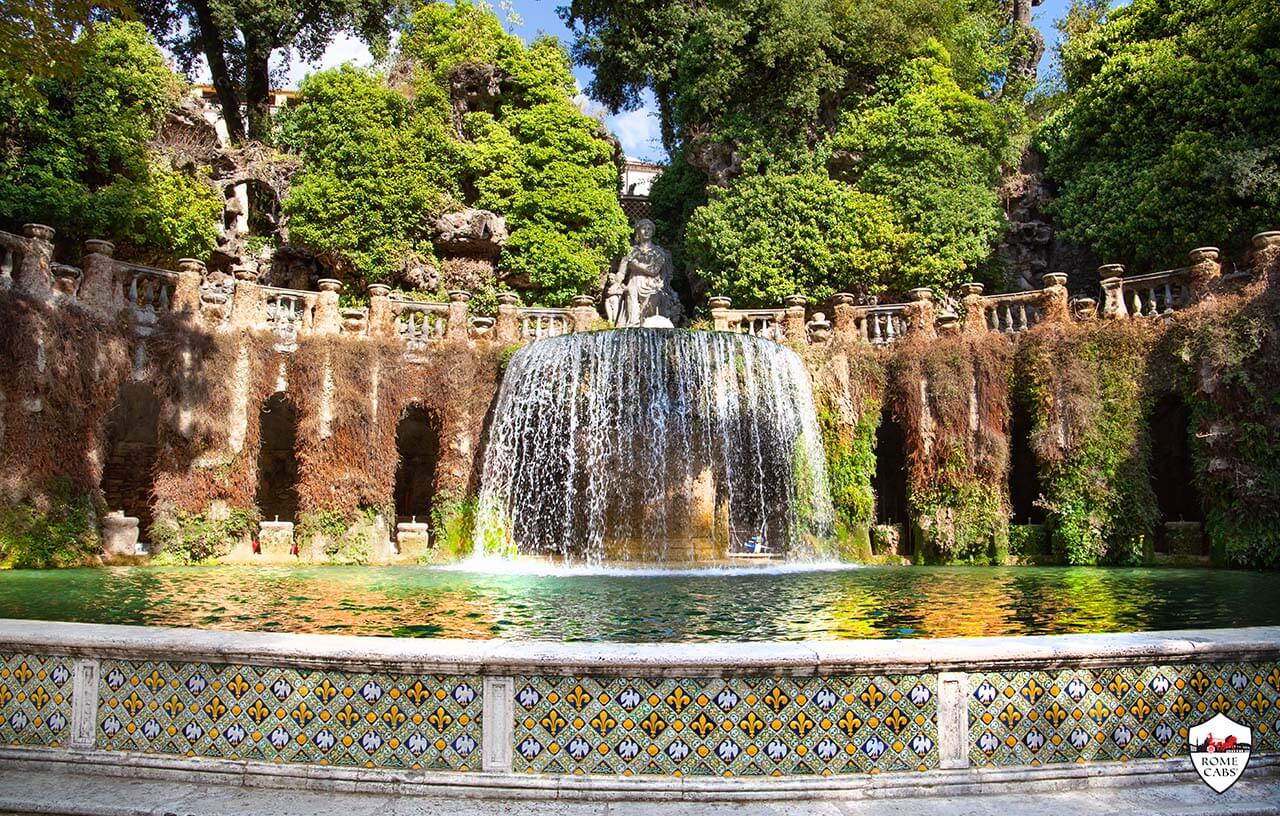
At the farthest end of the Hundred Fountains, you will arrive at the entrance to the Oval Fountain (Fontana dell’Ovato).
The fountain is a key element in Pirro Ligorio's elaborate iconological program, alongside the Fountain of Pegasus, the Hundred Fountains, and the Rometta Fountain, showcasing the villa's "theaters of water".
This fountain symbolizes the Tivoli landscape, featuring a central waterfall cascading into an oval basin. The fountain includes an artificial mountain resembling the Tiburtine Mountains, originally emitting water through concealed ducts among the rocks. Three colossal statues top the mountain: the Sybil Albunea with her son Melicertes in the center (by Gillis van den Vliete, 1568), and reclining figures of the Herculaneum and Anius Rivers on the sides (Giovanni Malanca, 1566).
Two nymphaea along the courtyard's sides house small fountains installed in 1569, originally containing Bacchus statues in peperino stone. The current stucco statues replaced them in the 17th century, linking to Sibyl's role as Bacchus's nursemaid.
In the building along the walkway, the Grotto of Venus, constructed in 1565-68, offers a cool meeting place on summer days. Originally, it featured a figure of Venus flanked by two putti playing with geese.
7. FOUNTAIN OF THE DRAGONS (Fontana dei Draghi)
Created in 1572 for Pope Gregory XIII’s visit
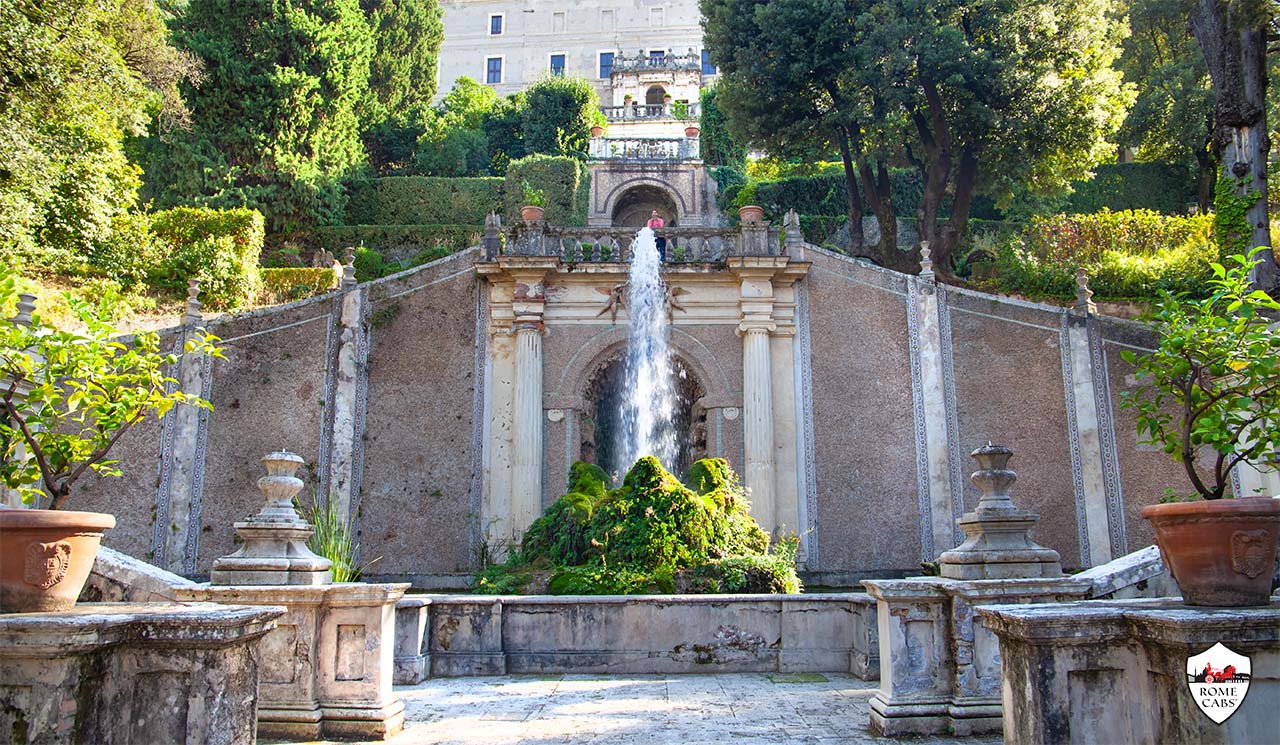
The Fountain of the Dragons (Fontana dei Draghi) is strategically positioned along the central vertical axis of the gardens at Villa d'Este. It aligns directly with the Villa and sits at the center of the original garden layout, just beneath the Hundred Fountains. Surrounding the fountain are two semi-circular ramps, designed to enclose the area and guide visitors to the elevated level above.
The fountain stands as the central point in the garden layout, aligned with the primary visual axis encompassing loggias and terraces. The oval cave, nestled between two ramps, connects the Avenue of the Dragons with the upper level of the Hundred Fountains.
Also known as the “Fountain of the Windmill” due to early 1600s water features, it once produced sound effects mimicking gunfire. Originally designed by Pirro Ligorio, these "warlike" sounds, manipulated by hydraulics expert Tommaso Ghinucci, were linked to the fountain's theme celebrating Hercules' 11th labor—capturing apples guarded by the dragon Ladon from the garden of Hesperides. The dragon Ladon, at the pool's center, takes the form of a Four Winged Dragon with a crest depicting a winged dragon, while two dolphins on the sides spout water jets.
8. THE FISH PONDS (Peschiere)
Works on these pools began between 1563-64 but were never completed
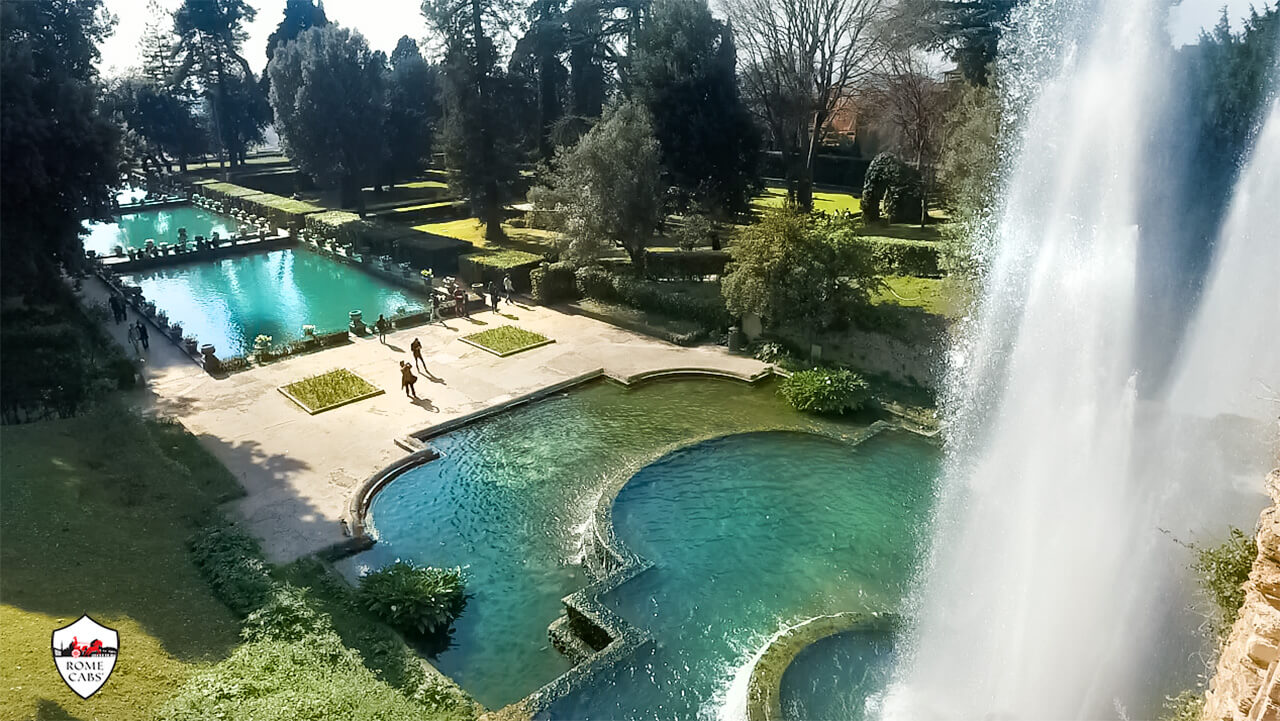
Further in the center of the gardens of Villa d’Este, you will come across the enormous fish ponds.
The Three Fish Ponds (Peschiere), initiated between 1563 and 1564, was intended to serve a dual purpose in Cardinal Ippolito II d'Este's grand garden plan. Initially designed by Pirro Ligorio, these expansive ponds not only functioned as reservoirs for the water flowing from the Fountain of Neptune but also played a practical role in providing fresh fish, ducks, and swans for the Cardinal's culinary delights. Ligorio's original vision included connecting the ponds to two other key water features—the Fountain of the Organ and the cascade, and the Fountain of the Seas. However, only two of the ponds were completed by the time of Ippolito's death in 1572.
In the late 16th century, a significant transformation occurred under the supervision of the Duke of Modena, who took charge of the Villa. The ponds underwent a redesign, replacing sixteen pilasters with ermes with eight pedestals supporting water-spouting vases and twenty-four large pots containing citrus trees.
This modification not only altered the aesthetic but also introduced a practical aspect to the ponds, aligning them with the picturesque foreground for cascades and fountains, notably the Fountain of Neptune. Today, these fish ponds stand as both a testament to the evolving designs of Villa d'Este and a reflection of their original purpose in sustaining the Cardinal's culinary extravagance.
9. FOUNTAIN OF NEPTUNE (Fontana di Nettuno)
In 1927 the fountain was constructed in its current form, transforming the Waterfall originally by Gian Lorenzo Bernini in 1661
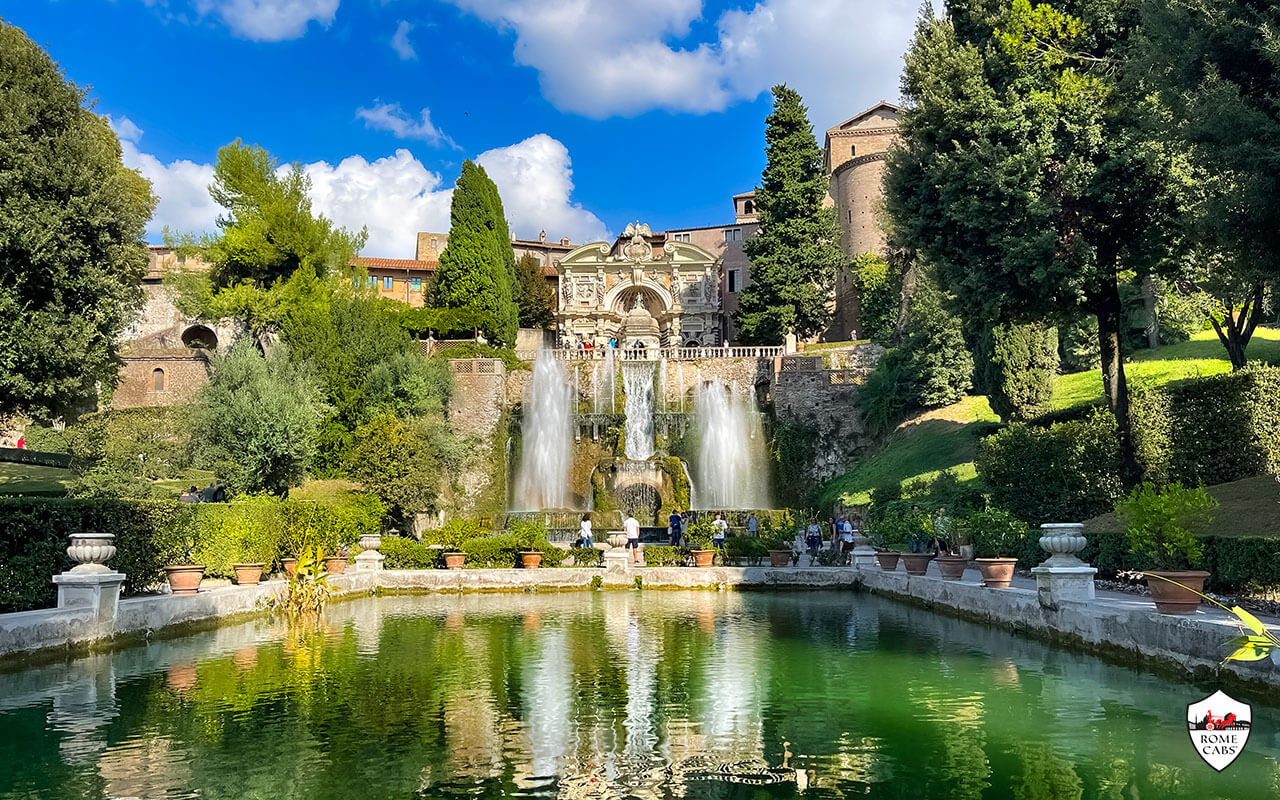
Dominating the front end of the Fish Ponds is an elaborate cascading fountain, the crowning achievement of Villa d’Este: the Fountain of Neptune (Fontana di Nettuno).
Originally designed by Bernini to complete Pirro Ligorio's plans, the fountain, left unfinished after Ippolito d’Este's death, featured a cascading design originating from the Fountain of the Organ forecourt. It passed over the Grottoes of the Sibyls on a suspended slide and rushed down a rocky slope into a pond with two lateral waterfalls.
Due to neglect, Bernini's work was lost, and in the 1930s, Attilio Rossi and Emo Salvati created the current fountain. It consists of scenographic water features with high jets and sprays symmetrically arranged around a central cascade reminiscent of Bernini's design.
In the grotto at the waterfall's base, the bust of Neptune gives the fountain its name. Various basins at different heights allow water to gently flow into pools on the flat area below.
10. Fountain of the Organ (Fontana dell'Organo)
Constructed in 1566 and designed by French engineer Luc Leclerc and his nephew Claude Venard
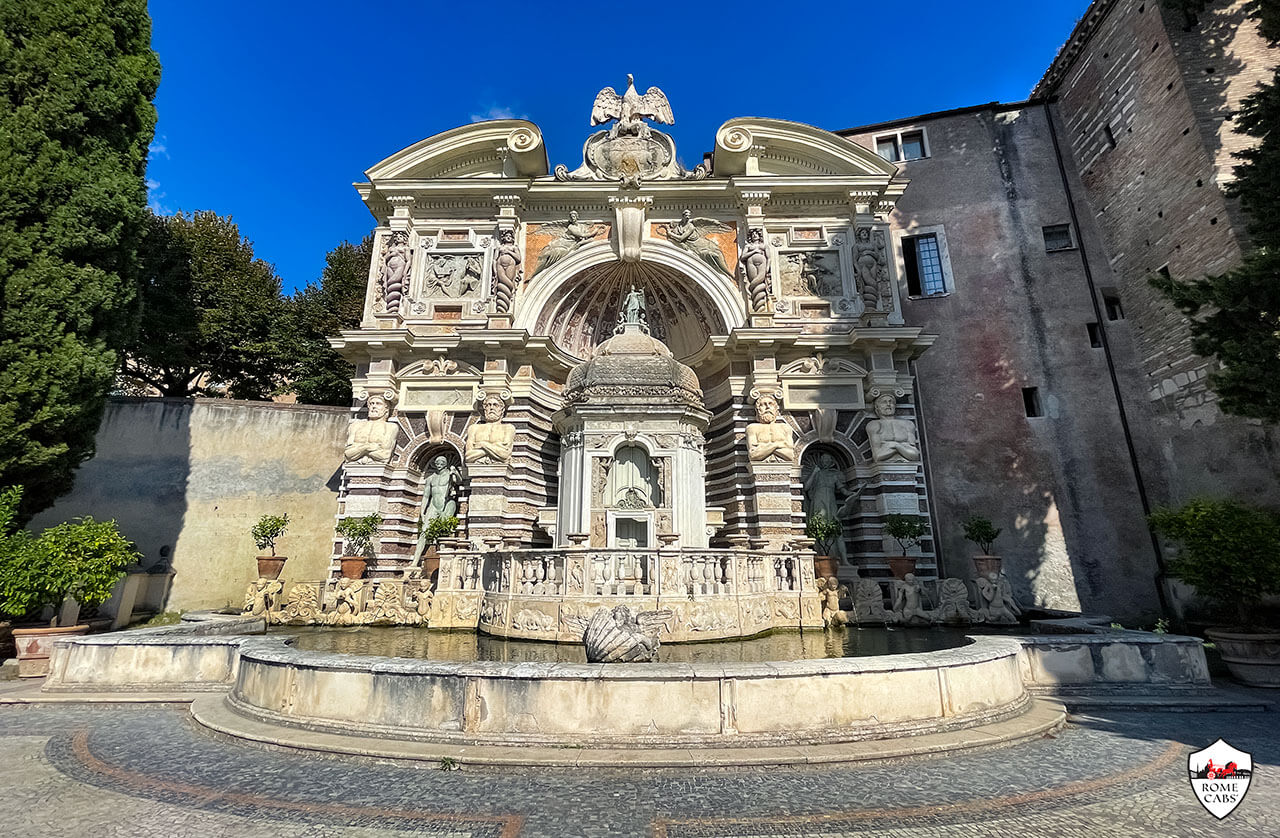
The Fountain of the Organ (Fontana dell'Organo) in Villa d'Este stands as an iconic masterpiece of engineering and artistic innovation, the first of its kind.
Upon its completion in 1571, the fountain astounded visitors, including Pope Gregory XIII, who insisted on inspecting its interior to verify there was no hidden musician producing the enchanting music. Concealed behind a massive masonry arch, the castellum aquae houses the water reservoir and hydraulic machinery. The water, manipulated through intricate whirlpools and a wind chamber, activates a complex system of pipes, producing melodious tunes.
Although the delicate mechanism required continuous maintenance, Cardinal Alessandro d'Este's 18th-century restoration introduced ornate additions, including statues and bas-reliefs. After years of careful restoration, the organ, now equipped with modern machinery while retaining its historical essence, plays again, treating visitors to the melodies of late Renaissance music. With 144 pipes and a captivating water-driven operation, the Fountain of the Organ remains a testament to Renaissance ingenuity and artistic vision.
* Find RomeCabs online also on:
